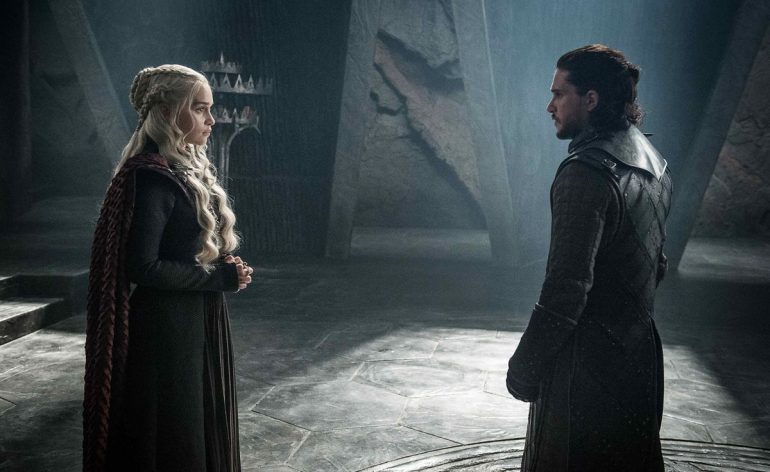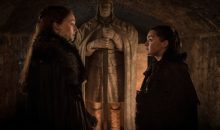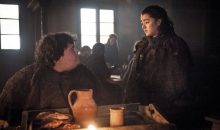Game of Thrones Season 7: The Queen’s Justice
And now the rains weep over his hall, without a soul to hear. “Rains of Castamere” is best known as the Lannister anthem, but it’s also a shibboleth for Game of Thrones‘s preoccupation with trauma. The continent of Westeros is littered with the debris of broken dynasties, and our modern characters, however heroic or despicable, are united by their collection of scars. In “The Queen’s Justice,” all that accumulated suffering pushed its way to the forefront, as people with a chance to change the world — or at least preserve it — found themselves hindered by old crimes, or reminded of their own losses at every turn.
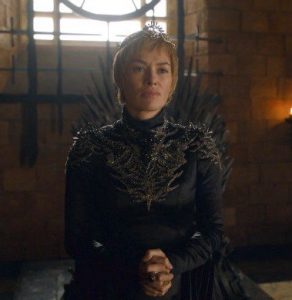
Pictured: gloating.
This was the Lannisters’ episode, particularly Cersei’s episode. Through six seasons, Cersei’s been brutalized and humiliated in ways that would seem more abominable if they weren’t interspersed with her own atrocities; every slight against her is avenged ten-fold, whoever gets hurt along the way. Freed of the constraints of rule-by-proxy, the threat of domestic enemies, and all but the barest towards conventional morality, she enjoyed the fruits of her most impressive maneuvers since the defeat of Ned Stark. Lena Headey was magnificent, smirking and vamping her way through court, dungeon, and bedroom alike without a care in the world.The image of Cersei in the torture chambers under the Red Keep, her lips ominously bright in the darkness, was one to linger. There’s nothing for a villain like a good gloat.
And why shouldn’t she gloat? Her counter-stroke rendered her enemies broken, massacred, quarreling among themselves. Her new admiral showed himself both effective and willing to play along with her politicking, and she kept her brother at her side. Even the winds were with her, granted Euron Greyjoy’s success in racing his fleet from one side of Westeros to the other in time to burn the Targaryen ships. (One might call it supernatural…) A few narrative folds and spindles, like that quick sailing and the Iron Bank’s very un-Braavosi comfort with the slave trade, enabled Cersei to effect a reverse that feels somewhat too sudden. We knew that Daenerys would need to face some roadblocks, but the Queen on the Iron Throne found a way to put a veritable Casterly Rock in her path.
While Cersei savored victory, Jaime struggled, as has been his wont since Season 2 or so. Lord Tywin’s most disappointing child faced mockery, embarrassment, and in a reverse of Season 4’s much-maligned “Breaker of Chains” scene, sexual coercion by his sibling. Even his unexpected military triumph came at the cost of his childhood home and culminated in a tongue-lashing from the mistress of them all. Jaime treated the doomed Olenna Tyrell politely, but he couldn’t help some very civilized gloating of his own, and the Queen of Thorns repaid him in kind with a savage revelation of how very much she cost the Lannisters. Mark Mylod’s direction stood out in this scene, giving both character and actress the dignified send-off they deserve, and framing Olenna’s execution not from the perspective of the victim, but the ostensible victor.
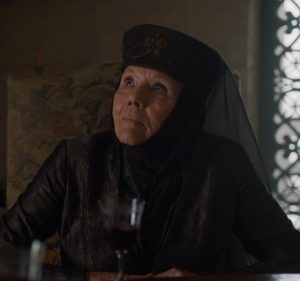
Best performance by someone whose hair we never saw.
It’s a fine scene, not just for the stellar dialogue and the satisfaction of Dame Diana Rigg’s all-timer of an exit, but for what it said about Jaime. The conquering general, half his army composed of traitors from the Reach, sacked an undermanned castle and graciously informed its lady that he’d secured her a clean and painless death. To expect any sort of gratitude for his half-measures was a stunning mix of arrogance and naivete that only Jaime Lannister could have mustered. Frustrating as his thematic wheel-spinning has been, it’s fun to watch the continued comeuppance of the despicable Kingslayer we first met talking shit to Ned Stark and defenestrating Bran.
And in classic Jaime fashion, his woes were nothing compared to the other victims of “The Queen’s Justice.” Start with Ellaria and Tyene Sand, subjected to a horrific fate reminiscent of the torturous deaths of Brandon and Rickard Stark (and shouldn’t that interest Jaime). Ellaria’s expanded role in the show, and the changes to the Dornish story, were partially a consequence of the presence of Indira Varma. Enough ink has been spilled over the Dornish mishap, but Varma’s near-mute acting in Ellaria’s possible exit scene, wheeling between hatred and horror and grief without benefit of a comprehensible word, was the best possible justification for why that choice was made.
Then there’s Yara Greyjoy, bloody but unbowed in her uncle’s clutches, and Theon, hauled half-drowned into a ship full of underwhelmed Ironborn who might prefer to throw him back; the soldiers of Casterly Rock, sacrificed by their liege as a decoy, and of Highgarden, stripped by the adaptation of their martial legacy (more on that below) and conquered offscreen by producer fiat. The Lannisters’ victory came at a price more dire than whatever the Iron Bank might exact. The misery of Queen Cersei’s reign is spreading across Westeros, compassing even her own birthplace, and there’s no better example of the rot at its heart than her careless exposure of her own incest. This is not a reign built to last.
But for the moment, she fares better than her rivals. The first meeting of the show’s predestined monarchs was as charged and portentous as one could hope for, with the terrific splendor of Dragonstone as a fitting backdrop. Daenerys’s court was outsized, inhuman, her string of titles echoing in the empty spaces to humble Jon Snow in his fur and iron, with his Flea Bottom herald. But as the scene went on, the two monarchs fenced over petty points of title and precedence, their advisers took petty pot-shots and quibble on wording, and it all bounced off the walls of Aegon’s fortress and made those inside it seem smaller by the sentence. Cersei bleeds the continent, the Night King marches, and the two people most likely to stop it were talking about Torrhen Stark in a big empty room that mocked them with every reverberation.
The meeting’s other challenge was a fantasy standard that Thrones has largely avoided up until now. In-universe skepticism of the sort advanced by Daenerys’s court is a challenge to navigate; if characters are too vociferous in their refusal to accept fantasy tropes, then the audience is invited to follow suit. It worked fine in earlier seasons when the drama was largely terrestrial and the fantastic aspects were confined to two or three of a dozen story arcs, but now that the story is cohering, scoffing at “white walkers” and “dragonglass” is an attack on suspension of disbelief. Plot conventions required some distrust between potential allies, but hopefully going forward the conflict between Dragonstone and Winterfell will find other methods of expression.
All the same, I’d count the scene a triumph, and its small-scale follow-ups even moreso. Tyrion and Jon’s reunion was as highly anticipated as any not between two Starks. Their friendly-but-fraught bit of back-channel discussion both revisited one of Thrones‘s early friendships and gave Tyrion a better show of political acumen than nearly anything he’s done as a Targaryen courtier thus far. And Jon and Daenerys fared better as dragon-watchers than as debating monarchs. Emilia Clarke does well inhabiting the string of titles beneath the crown, but she’s at her best as Dany, the ambitious, homesick, tender-hearted woman who believes she’s lived through all this for a reason. There’s a lot riding on the meeting of ice and fire — politically, martially, prophetically, and quite possibly romantically — and seeing the two principals take steps towards a human connection was the most important part of the twenty-odd minutes we spent on Dragonstone.

tfw ur little bro is WILDLY insensitive
But there’s still a related mystery left to untangle. Bran Stark’s story has run aground in the last few seasons, challenged by both relatively sparse on-page material and a general disconnect from the quickly-uniting plot threads. Still we need Bran, because Bran has the answers to our questions, so back into the world he comes. His reunion with his sister, in its simplicity and sadness, had more weight than any of the pyrotechnics and gloomy necromancy of his tutelage by the Three-Eyed Raven. We watched Sansa assume power with competence, take steps to face the various dangers of winter, see both the big picture and the small details that made it up. And then she saw her brother.
Sophie Turner is getting to be an old hand at tearful reunions, but this one plucked at the heartstrings in a different way. In Sansa’s switch from hard-won leadership to vulnerability, and Bran’s remote response, we saw a gap wider and more painful than any of the other conflicts of “Justice.” The dialogue of their reunion under the heart tree was awkward, but the performances of Turner and Isaac Hempstead Wright did the heavy lifting to show us just how far the young Starks have traveled from Ned and Catelyn’s hearth. Bran is a living chronicle of Westeros’s history, and that history is writ in blood and fire. When he opts to demonstrate his powers by recalling Sansa’s mockery of a wedding night, it’s less deliberate cruelty than Bran speaking the only language that he and normal people can both understand.
The most ambitious thing “The Queen’s Justice” attempted was to engage with the trauma of Game of Thrones on an out-of-universe level. Sansa’s rape, the mishandling of Jaime and Cersei’s scene in the sept, and the various sexual traumas inflicted on Daenerys throughout her screen life — all were brought to the forefront in this episode. Thrones can’t undo the mistakes of the past, no more than the people of Westeros can. But while kings and queens can at least try to see past old grudges, Benioff, Weiss & co. are inescapably tied to their previous artistic choices. It’s a dangerous choice to lean into that history, but it’s also the right one.
A few quick hits:
- It’s unfortunate that Thrones chose to take the floral imagery of the Tyrells and their domain at face value, rather than lean into the poetic irony of Westeros’s richest, most powerful province and its mighty rulers, represented by a pretty flower. Loras “gay cartoon” Tyrell suffered the most from this, and it’s worth recalling the inspiration for the Reach was medieval Aquitaine, where Eleanor ruled and Richard grew to adulthood. Not exactly a place known for its unimpressive showing in a fight.
- Nice touch that the servant who catches Jaime & Cersei is wearing an imitation of the Queen’s pageboy haircut. Cersei’s hair continues to be the biggest #influencer and #thoughtleader in Westeros.
- Today in “clever scene changes,” we had Littlefinger’s hoarse admonition to know everything and fight everyone immediately leading to the appearance of the one character qualified to do exactly that. One wonders how long it’ll take for Bran to get around to exposing Petyr Baelish’s lifelong history of fucking over the Starks.
- I really thought Samwell was going to get kicked out of the Citadel, and I’m not sure what contrivances will get him back into the main plot. I also genuinely cannot remember whether the show forgot Jeor Mormont’s dying wish (witnessed by Sam) for his son to take the black, or whether that was a moment that didn’t make it through adaptation. The perils of analyzing two stories at once!
- There’s a lot to unpack about the show’s political presentation of Daenerys as both destined monarch and “revolutionary,” two concepts profoundly at odds even before the questionable status of her “free” Unsullied is brought in. This review has already run long enough, but rest assured, we’ll be revisiting this in the future.

